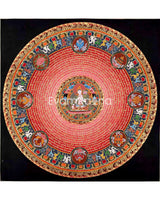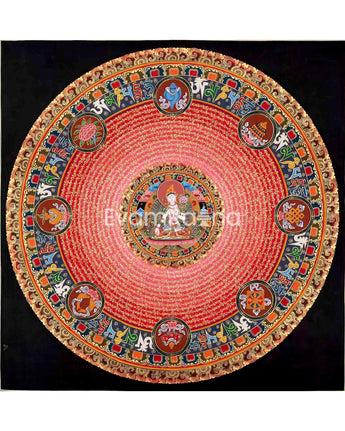
White Tara Mantra Mandala Thangka | Sacred Thangka Painting

100% AUTHENTIC

HANDMADE

FREE SHIPPING
White Tara Mantra Mandala Thangka
About Our Thangka :
This intriguing and spiritually significant White Tara Mantra Mandala Thangka captures the spirit of White Tara, who is regarded in Tibetan Buddhism as a goddess of compassion and healing. This delicately hand-painted thangka is intended to summon the benefits and healing energies connected with White Tara. It serves as a visual depiction and a sacred object of devotion.
White Tara is shown in the thangka's center in a pose that is both graceful and kind. She is radiantly dressed in white robes that represent her transcending purity and knowledge. The tranquil smile on her face, which reflects her limitless compassion and maternal presence, is expertly captured by the artist. The mandala, which wraps around White Tara, is a complex composition of mantras, sacred geometric designs, and symbolic elements. These components blend in perfect harmony to produce a potent visual representation of the healing energies and transformative properties connected to White Tara's mantra.
The White Tara Mantra Mandala Thangka is a talisman for protection, healing, and spiritual development in addition to being a visual aid for meditation and devotion. It is thought to emit blessings and uplifting energies, giving anyone who interacts with it consolation, comfort, and inspiration.
Introduction To Mandala :
Mandala literally means a circle. The tibetan word for madala is Kyilkhor , which means “centre and surrounding environment.” In simple terms it is a circle used as a visual aid for concentration and introversive meditation. Meditating using a mandala leads to the attainment of insights and it helps to increase one’s level of concentration . It also helps to activate forces within oneself which culminates into “Siddhi ” or super – natural forces.
The mandala is the graphic representation of this process . It is not only theoretical but practical as an operational scheme involving a clear plan for practical realization of the process within oneself . It thus becomes an instrument ( Yantra ) . It is believed that by just looking at a mandala one’s soul is spiritually purified. Thus , a mandala represents the palace of purity a magic circle cleansed of spiritual obstacles and impurities . The square of the sacred palace is enclosed in multiple circles of flame, vajra and lotus . These three circles forming the outer rims of the mandala symbolizes enlightenment , which the meditating person must gain , before he or she can enter the illuminated palace . The mandala then consists of the inner square where the deity of the mandala resides .
The name of the mandala is determined according to the deity residing in the center of the sacred palace.
------------------------------------------------------------------
Size: "30/76cm (width) x 30"/76 cm (height)
Materials: Cotton Canvas, Acrylic Colors, Genuine 24K Gold
------------------------------------------------------------------
THIS THANGKA IS HAND-PAINTED IN THE TRADITIONAL STYLE AND THE QUALITY IS HIGH
What does White Tara mantra “MAMA AYUR PUNE GYANA PUNTIN KURU SOHA” define?
Mama = mine, means that I would like to possess the following qualities.
Ayurur = long life
Punene = merit that comes from living life ethically.
Gyana = wisdom
Puntin = increase
Kuru = do so! do it now!
Soha= hail, or may blessings be upon
Shipping & Returns
We ship worldwide. Orders dispatch in 2–3 business days. International delivery typically arrives in 4–10 business days via DHL Express, depending on destination and carrier conditions. All items ship free globally.
Returns are accepted within 14 days of delivery. Products must be returned in original condition for a refund to be issued once received and inspected. Terms and conditions apply.











